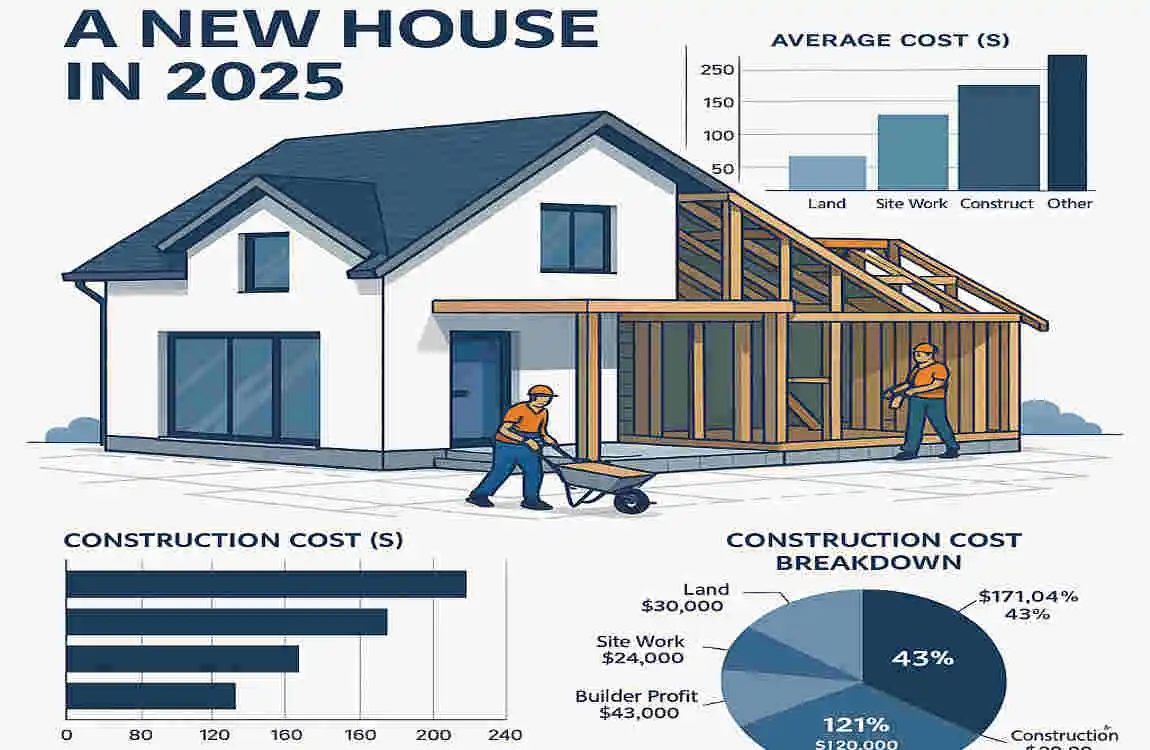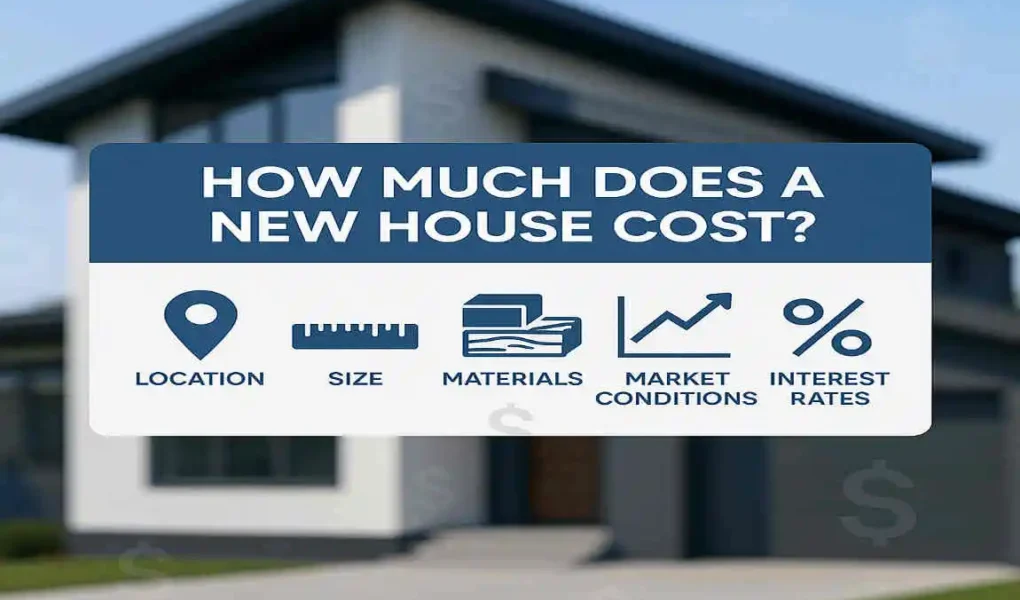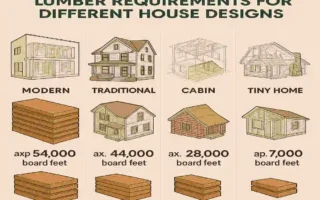A new house in 2025 typically costs between $100 and $200 per square foot to build, with the median price around $150 per square foot. For an average American family home of about 2,000 square feet, this translates roughly to $200,000 to $400,000. Actual prices vary significantly based on factors such as location, material and labor costs, and the size and scope of the home. Key factors affecting home prices today include rising mortgage interest rates, limited housing inventory, affordability challenges, demographic shifts increasing demand, and consumer confidence in the economy and housing market. These factors collectively shape how much new houses cost and influence buyer decisions.
Average Cost of Building a New House in 2025

Let’s start by looking at the current average costs of building a new house in 2025. Nationally, the price per square foot ranges from $125 to $300, depending on various factors we’ll explore later. To give you a better idea, let’s consider a few examples:
- A small 600-square-foot home might cost between $75,000 and $180,000.
- A typical family-sized home of 2,000 to 2,500 square feet could cost between $250,000 and $750,000.
- For a larger 4,000+ square foot home, you might be looking at $500,000 to $1.2 million or more.
Keep in mind that these are just general estimates. The median price for a new home in 2025 is around $400,000 to $500,000 for a 2,000- to 2,500-square-foot house.
Now, you might be wondering how building a new house compares to buying a pre-existing one. Generally, building from scratch can be more expensive upfront, but it allows you to customize your home to your exact needs and preferences. On the other hand, buying an existing home can be more cost-effective initially, but you may need to compromise on certain features or invest in renovations.
It’s also important to note that regional differences significantly influence the overall cost of a new house. For example, building in a major city like New York or San Francisco will likely be more expensive than in a rural area due to higher land and labor costs.
Key Factors Affecting New House Cost Today
Now that we have a general idea of the average costs, let’s dive deeper into the key factors that influence the price of a new house in 2025.
Location
One of the most significant factors affecting the cost of a new house is its location. Urban, suburban, and rural areas all have different price points due to variations in land availability, demand, and local regulations.
- Urban areas tend to have the highest costs due to limited space and high demand. You might pay a Premium for a smaller lot size and face more stringent building codes.
- Suburban locations often offer a balance between affordability and accessibility. You may have more land to work with, but costs can still be higher than in rural areas.
- Rural settings typically have the lowest land costs, but you’ll need to consider factors such as distance to amenities and potential infrastructure costs.
Materials and Supply Chain
The availability and price of construction materials also play a crucial role in determining the cost of a new house. Inflation, supply chain disruptions, and material shortages can all lead to increased expenses.
- Lumber, steel, and concrete are some of the most commonly used materials in home construction. Fluctuations in their prices can significantly impact your overall budget.
- Specialty materials, such as energy-efficient windows or high-end finishes, can also add to the cost but may provide long-term savings and increased home value.
Labor Costs
Labor costs are another essential factor to consider when building a new house. Shortages of skilled workers, rising wages, and regional differences can all affect the price you pay for construction services.
- General contractors typically charge between 10% to 20% of the total project cost for their services, which includes overseeing the entire construction process.
- Specialized tradespeople, such as electricians, plumbers, and HVAC technicians, may charge either an hourly rate or a flat fee for their work.
- Regional differences in labor costs can be significant, with higher wages in major metropolitan areas than in rural areas.
Size and Design Complexity
The size and complexity of your home’s design will also impact the overall cost. Larger homes with more rooms and intricate architectural features will generally be more expensive to build.
- Square footage is a primary driver of cost, as more space requires more materials and labor.
- The number of stories can also affect the price, with multi-story homes often costing more due to additional structural work and safety considerations.
- Custom features like vaulted ceilings, built-in cabinetry, or unique floor plans can add to the expense but create a one-of-a-kind home.
Market Demand and Inventory
The current state of the housing market can also influence the cost of a new house. Tight inventory and high buyer demand can drive up prices, while a surplus of homes may lead to more competitive pricing.
- Low inventory can create a seller’s market, where builders and sellers have more leverage to set higher prices.
- High buyer demand, particularly in desirable locations, can lead to bidding wars and higher costs.
- Market fluctuations can be challenging to predict, so it’s essential to stay informed about local trends and work with a knowledgeable real estate professional.
Mortgage Rates and Financing
Finally, mortgage rates and financing options play a significant role in determining the overall cost of a new house. Interest rates directly impact your monthly payments and long-term affordability.
- Current mortgage rates in 2025 are around 4% to 5% for a 30-year fixed-rate loan, but these can fluctuate based on economic conditions and lender policies.
- Down payment requirements typically range from 3% to 20% of the home’s purchase price, with larger down payments resulting in lower monthly payments and potentially better interest rates.
- Financing options like construction loans or home equity lines of credit can help fund your new home, but they come with their own set of costs and considerations.
Detailed Breakdown of Cost Components
Now that we’ve covered the key factors affecting the overall cost of a new house, let’s take a closer look at the specific components that make up your budget.
Land Acquisition
The first step in building a new house is acquiring the land on which to build it. Land costs can vary widely depending on location, size, and other factors.
- Urban lots may cost $100,000 to $500,000 or more per acre, while rural land can be as low as $5,000 to $20,000 per acre.
- Lot size and shape can also impact the price, with larger, more regularly shaped parcels typically costing more.
- Additional costs, such as surveys, title searches, and closing fees, should also be factored into your land acquisition budget.
Permits and Fees
Before you can start building, you’ll need to obtain the necessary permits and pay various fees to your local government.
- Building permits typically cost between $500 $2,000, depending on your location and the size of your project.
- Impact fees may be charged to offset the cost of new infrastructure, such as roads, schools, or utilities, and can range from $2,000 to $20,000 or more.
- Inspection fees will be required at various stages of construction to ensure compliance with local building codes, and may add another $500 to $2,000 to your budget.
Foundation and Structural Work
The foundation and structural components of your home are crucial to its stability and longevity. These elements can account for a significant portion of your overall budget.
- Foundation costs vary by type (e.g., slab, crawl space, or basement) and home size, but typically range from $5,000 to $25,000.
- Framing and structural work can add another $10,000 to $50,000 or more, depending on the complexity of your design and the materials used.
- Roofing is another essential structural component, with costs ranging from $5,000 to $20,000 depending on the type of roofing material and the size of your home.
Interior and Finishes
Once the structural work is complete, it’s time to focus on your home’s interior. Flooring, cabinetry, fixtures, and custom finishes can all contribute to the overall cost.
- Flooring costs vary widely by material type, ranging from $2 to $20 per square foot or more.
- Cabinetry and countertops can add another $5,000 to $20,000 to your budget, depending on the quality and style of the materials.
- Fixtures like lighting, plumbing, and appliances can range from $5,000 to $20,000 or more, depending on your preferences and the size of your home.
- Custom finishes, such as trim work, paint, and wall treatments, can add $2,000 to $10,000 to your budget while also creating a unique, personalized look for your home.
Utilities and Infrastructure
Installing the necessary utilities and infrastructure is another essential component of building a new house. These costs can vary based on your location and the specific requirements of your project.
- Plumbing costs typically range from $5,000 to $15,000, depending on the size of your home and the complexity of the system.
- Electrical work can add $5,000 to $15,000 to your budget, depending on the number of outlets, lighting fixtures, and other electrical components.
- HVAC (heating, ventilation, and air conditioning) systems can cost between $5,000 $20,000 or more, depending on the size of your home and the efficiency of the equipment.
Additional Features
Finally, you may want to consider additional features that can enhance the comfort, functionality, and value of your new home.
- Energy-efficient additions, such as solar panels, geothermal heating, or high-efficiency windows, can add $5,000 to $20,000 or more to your budget while also providing long-term savings on utility bills.
- Landscaping costs vary widely based on the size of your lot and the complexity of the design, but typically range from $2,000 to $10,000 or more.
- Garages and outbuildings can add $10,000 to $30,000 to your budget, depending on the structure’s size and features.
- Basements can be a significant expense, costing $10,000 to $50,000 or more, depending on the space’s size and finish level.
The Impact of Economic and Market Trends in 2025

As you plan your new home construction, it’s essential to consider the broader economic and market trends that can impact your costs and timeline.
Inflation
Inflation is a significant factor to consider when building a new house in 2025. Rising prices for materials and labor can increase your overall budget, so it’s crucial to factor in potential inflation when planning your finances.
- Construction materials like lumber, steel, and concrete have seen significant price increases in recent years, and this trend is expected to continue in 2025.
- Labor costs are also rising due to shortages of skilled workers and increased demand for construction services.
Mortgage Rates
Mortgage rates play a crucial role in determining the affordability of a new home. In 2025, rates are expected to remain relatively low compared to historical averages, though they may still fluctuate with economic conditions.
- Current mortgage rates are around 4% to 5% for a 30-year fixed-rate loan, but they can change based on factors such as inflation, employment, and monetary policy.
- Locking in a rate early in the construction process can help you plan your budget more effectively and protect against potential rate increases.
Inventory Shortages
Inventory shortages continue to be a challenge in the housing market, with demand often outpacing the supply of new homes. This can lead to increased costs and longer construction timelines.
- Tight inventory can create a seller’s market, where builders and sellers have more leverage to set higher prices.
- Delays in material delivery and labor shortages can also contribute to longer construction timelines and increased costs.
Housing Market Predictions
As you plan your new home construction, it’s helpful to consider housing market predictions for 2025 and beyond. While no one can predict the future with certainty, experts offer some insights into potential trends.
- Housing prices are expected to continue rising in many markets, driven by strong demand and limited inventory.
- Interest rates may increase slightly in response to inflation, but they are still expected to remain relatively low compared to historical averages.
- New construction is likely to remain a significant part of the housing market, as builders work to meet demand and address inventory shortages.
Tips for Managing and Estimating New House Costs
Now that we’ve covered the key factors and components that influence the cost of a new house, let’s discuss some tips for managing and estimating your budget effectively.
Budgeting Effectively
Creating a comprehensive budget is essential when building a new house. Here are some tips to help you plan your finances:
- Research costs thoroughly, using resources like this article and local market data to get a realistic idea of what to expect.
- Build in a contingency fund of 10% to 20% of your total budget to account for unexpected expenses or changes to your plans.
- Prioritize your spending based on your needs and wants, focusing on the most critical features and finishes for your new home.
Selecting the Right Location and Materials
Choosing the correct location and materials can help you control costs and stay within your budget. Consider these factors:
- Location plays a significant role in determining the overall cost of your new home. Research different areas to find the best balance of affordability and amenities.
- Materials can also impact your budget, so consider options like prefab or modular construction to save on costs without sacrificing quality.
- Energy efficiency should also be a priority, as investing in insulation, windows, and appliances can yield long-term savings on utility bills.
Working with Builders and Contractors
Collaborating with experienced builders and contractors is essential for managing costs and ensuring a successful construction process. Here are some tips:
- Get multiple bids from different builders and contractors to compare prices and services.
- Communicate openly about your budget and expectations, and work together to find cost-effective solutions.
- Monitor progress closely and address any issues or changes in scope promptly to avoid unexpected expenses.
Considering Prefab or Modular Homes
Prefab or modular homes can be an excellent option for those looking to save on construction costs without sacrificing quality. Here’s what you need to know:
- Prefab homes are built in a factory and then assembled on-site, which can reduce labor and material costs.
- Modular homes are constructed in sections (modules) and then joined on-site, offering greater design and layout flexibility.
- Both options can be more affordable than traditional stick-built homes, with prices starting at around $100 to $150 per square foot.
Planning for Unexpected Expenses
No matter how well you plan, unexpected expenses can arise during construction. Here’s how to prepare:
- Build in a contingency fund of at least 10% to 20% of your total budget to cover unforeseen costs.
- Stay flexible and be ready to make adjustments to your plans if necessary to stay within your budget.
- Communicate openly with your builder and contractors about any issues or changes, and work together to find solutions that fit your budget.




